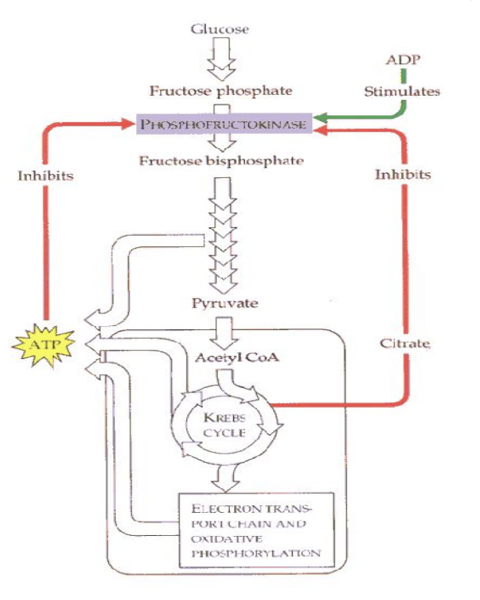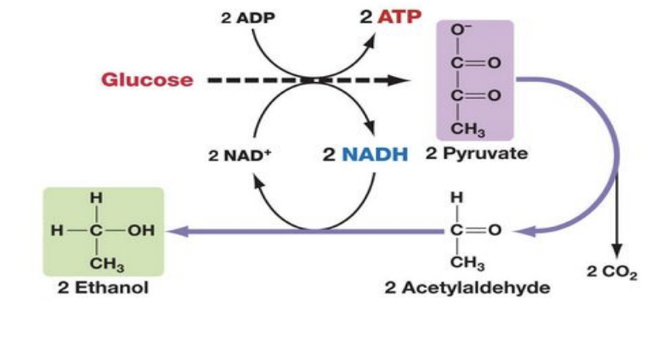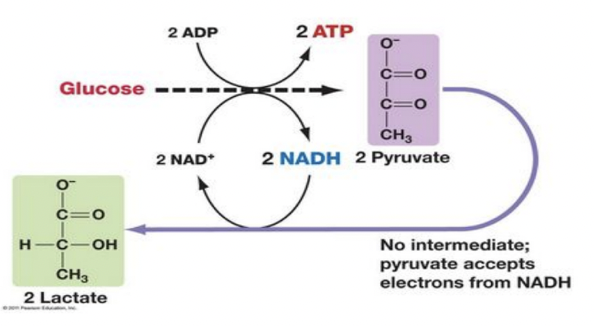
12-12: Regulating Cellular Respiration and Alternatives
Stimulation and Inhibition
cells control cellular respiration by feedback inhibition of ATP or citrate on the phosphofructokinase (PFK) enzyme in glycolysis and pyruvate dehydrogenase complex (PDC) when it gets oxidized
PFK can be stimulated by ADP when ATP levels are low
PDC is inhibited by acetyl-CoA, NADH, and ATP while pyruvate & ADP activate it

Anaerobic Pathways
the electron transport chain & chemiosmosis are able to work because of oxygen as a final electron acceptor
still 2 ways for eukaryotes to make ATP (though they’re less effective)
Fermentation
uses an organic molecule as the final electron acceptor (instead of oxygen)
not considered respiration
even without oxygen, glycolysis can have a net gain of 2 ATP → just need a way to oxidize NADH back to NAD+
2 types: alcohol & lactate fermentation
depending on the organism, this can be a primary/secondary pathway
Alcohol Fermentation
ethanol fermentation
done by bacteria & yeasts
normal glycolysis followed by decarboxylation of pyruvate into acetaldehyde
acetaldehyde then oxidizes NADH back into NAD+ while being converted into ethanol
only 2 ATP produced

Lactate Fermentation
supplementary system in eukaryotes occurs in our muscles
due to not getting enough oxygen to produce sufficient ATP to meet our demands
excess pyruvate is converted into lactate through the oxidation of NADH to NAD+
lactate is transferred to the liver where it is converted back into pyruvate & then into glucose
only 2 ATP produced

Anaerobic Respiration
many prokaryotes can use SO₄⁻², NO₃⁻⁻ and Fe³⁺ as electron acceptors in their electron transport chains in order to live in environments without oxygen
Excess Sugar Molecules
if ATP is not needed and glycolysis is inhibited the sugar molecules can be stored as glycogen or fats
Glucose Alternatives
cellular respiration can run on proteins & fat as well as carbohydrates
different enzymes break these molecules down so they can enter the process at different places
proteins need to have the nitrogen removed before they can be used for energy - this is called deamination
fats are broken into glycerol & fatty acids as a first step
Protein Deamination
each amino acid needs a different enzyme to remove the amino group
ammonia is a waste product that gets converted to urea and excreted in urine
the Nitrogen needs to be dealt with in breaking the protein down

Amino Acids in Respiration
different amino acids enter the respiration process at different points once the amino group is removed
the place where the amino acid enters depends on how many carbons it has
12-12: Regulating Cellular Respiration and Alternatives
Stimulation and Inhibition
cells control cellular respiration by feedback inhibition of ATP or citrate on the phosphofructokinase (PFK) enzyme in glycolysis and pyruvate dehydrogenase complex (PDC) when it gets oxidized
PFK can be stimulated by ADP when ATP levels are low
PDC is inhibited by acetyl-CoA, NADH, and ATP while pyruvate & ADP activate it

Anaerobic Pathways
the electron transport chain & chemiosmosis are able to work because of oxygen as a final electron acceptor
still 2 ways for eukaryotes to make ATP (though they’re less effective)
Fermentation
uses an organic molecule as the final electron acceptor (instead of oxygen)
not considered respiration
even without oxygen, glycolysis can have a net gain of 2 ATP → just need a way to oxidize NADH back to NAD+
2 types: alcohol & lactate fermentation
depending on the organism, this can be a primary/secondary pathway
Alcohol Fermentation
ethanol fermentation
done by bacteria & yeasts
normal glycolysis followed by decarboxylation of pyruvate into acetaldehyde
acetaldehyde then oxidizes NADH back into NAD+ while being converted into ethanol
only 2 ATP produced

Lactate Fermentation
supplementary system in eukaryotes occurs in our muscles
due to not getting enough oxygen to produce sufficient ATP to meet our demands
excess pyruvate is converted into lactate through the oxidation of NADH to NAD+
lactate is transferred to the liver where it is converted back into pyruvate & then into glucose
only 2 ATP produced

Anaerobic Respiration
many prokaryotes can use SO₄⁻², NO₃⁻⁻ and Fe³⁺ as electron acceptors in their electron transport chains in order to live in environments without oxygen
Excess Sugar Molecules
if ATP is not needed and glycolysis is inhibited the sugar molecules can be stored as glycogen or fats
Glucose Alternatives
cellular respiration can run on proteins & fat as well as carbohydrates
different enzymes break these molecules down so they can enter the process at different places
proteins need to have the nitrogen removed before they can be used for energy - this is called deamination
fats are broken into glycerol & fatty acids as a first step
Protein Deamination
each amino acid needs a different enzyme to remove the amino group
ammonia is a waste product that gets converted to urea and excreted in urine
the Nitrogen needs to be dealt with in breaking the protein down

Amino Acids in Respiration
different amino acids enter the respiration process at different points once the amino group is removed
the place where the amino acid enters depends on how many carbons it has
 Knowt
Knowt